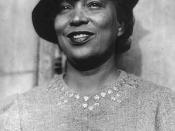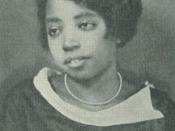Salah O. Ahmed Intro to Afro-American Literature Professor Todd Duncan (This could use a longer conclusion) Inner Peace In the essays, "How it Feels to be Colored Me"ÃÂ and "On Being Young-a Woman-and Colored"ÃÂ, the authors, Zola Neale Hurston and Marita Bonner, respectively, tell a similar story of having grown up and had to deal with racism in the Post-Bellum Era. In their appeal to a new generation, one less stigmatized by slavery and more hopeful about the future than its predecessor, Hurston and Bonner take divergent paths to point to a common understanding. The convergence between their works centers on the idea that in order for the young people of their generation to achieve a sense of peace with the world around them, they must first find peace within themselves.
Hurston and Bonner wrote with a passion that was quite different from that felt by the authors who had come before them.
While the older generation was still dealing with memories of slavery and gross injustices, the newer was looking to the future and, having migrated north, a life that bore little resemblance to anything that African-Americans-at-large had ever experienced. The period, encompassing the literature as well as blues, jazz and dance, came to be known as the Harlem Renaissance and was influenced in large part by this younger generation. This was literature that was marked not only by extraordinary creativity but also by new perspectives and motivations. Whereas the authors of the Post-Bellum era sought to explore slavery to its roots, the new writers chose to delve enthusiastically into the present. While the first were bent on carefully paving the way for a people newly released from the nightmare of bondage, the second bulldozed their way into the hearts and minds of the masses, inspired by the growing appeal of jazz, blues and dance, and stimulated by the readiness of newspapers and magazines to carry their message. The literature of the Post-Bellum, concerned primarily with healing an injured spirit and addressing practical concerns, such as illiteracy, gave way to the Harlem Renaissance which marked an explosion of African-American creativity that had no less ambitious a goal than to reveal a people's suppressed, yet vibrant genius.
It was in this atmosphere that Hurston and Bonner had found their calling and become writers. In their essays, they write with enthusiastic voices though they do not begin with equal optimism. In "How it Feels to be Colored Me"ÃÂ, Hurston describes the innocence of her youth, growing up in a predominantly African-American community, the memory of which she seems to relish. That there has been a change in the African-American state of affairs is obvious as she describes her mutually cordial relationship with white visitors traveling through her town. Rather than describing her early attitude towards these visitors as naÃÂïve, she seems to enjoy its innocence and sincerity. "It is clear that I was the first "ÃÂwelcome-to-our-state' Floridian, and I hope the Miami Chamber of Commerce will please take notice."à(1008) In her voice there is the sense of joy of playing host to these white visitors who seem to appreciate her hospitality as much as she appreciates their visit. Though it is certain that at her age she was not immune to prevailing attitudes about white people, and that they should be approached cautiously, at best, and at worst with outright distrust, she seems to have found an inner voice in which she places her trust. It is this voice that pervades the Harlem Renaissance as a whole, seeming to guide a generation that is coming of age at a time when opportunities appear to abound, free of the trappings of slavery and full of the promise of opportunity.
It is with this optimism that Zora continues in describing her move to a community where she no longer feels the sheltered. Her new surroundings, with their assortment of people who are mostly white, contribute to her unfamiliar consciousness of being black, which is a concept that she had, until then, pondered with little seriousness. Unwavering in her optimism, however, she describes herself as not being "tragically colored. There is no great sorrow dammed up in my soul"æI have seen that the world is to the strong regardless of a little pigmentation more or less."àUsing allegory, she describes the state of affairs as she sees them. "The terrible struggle that made me an American out of a potential slave said "ÃÂOn the line!' The Reconstruction said "ÃÂGet set!'; and the generation before said "ÃÂGo!'"à(1009) Her determination to live life to the fullest without being bogged down by feelings of inferiority is uncompromising. Such will power is at the center of the Harlem Renaissance movement and it is this force on which Hurston draws to inspire her audience with her attitude that success finds its initial source in stead-fasted self-confidence.
Bonner heads towards a similar conclusion but along the way considers her reality from a different perspective. In her essay, "on Being Young-a Woman-and Colored"ÃÂ, she describes her engagement with other African-Americans, from whom she grew up largely detached, in metaphorical terms. As she joins their midst, she writes about how a "warm untouched current flows through them-through you-and drags you out into the deep waters of a new sea of human foibles and mannerisms; of a peculiar psychology and prejudices."à(1206) She is not fully at ease with what she terms a "peculiar group"æcut off, flung together, shoved aside in a bundle because of color and with no more in common. She is impressed by the fact that the union which binds African-Americans is an artificial one from which its members, pressured by their conditions of poverty and stagnation, constantly seek to escape. "Those at the bottom crushed"æby those on the top. Those on top leaping, leaping; leaping to scale the sides; to get out."àClearly, Bonner is disappointed with what she views as forced coexistence. She finds no solace in those distractions meant to steal attention away from the hard realities of life. "Music and dancing and much that is wit and color"æbut they are like the richest chocolate"æthat make plain whole bread taste like ashes."à(1207) These are nothing more to Bonner than devices that obscure the fact that African-Americans, unlike their white counterparts, are not enjoying progress and financial independence, truer indicators of success. Like Hurston, Bonner is adamant about her views and passionate in a way that is characteristic of this period, but she is uncompromising in her criticism of what she offers is a grim reality full of false hopes.
Bonner lays the blame for this artificial existence squarely on the insensitivity of white people who have become desensitized to the plight of African-Americans. She directs her frustration at people whose "Anglo Saxon intelligence is so warped and stunted."àEven as she is upset with these circumstances, she yearns for a spiritual connection that would reach beyond the obvious and tangible. She decries the fact there seems to be no room for "discrimination of the right sort. Discrimination that the best minds have told you weighs shadows and nuances and spiritual differences before it catalogues."à(1207) Obvious in her reproach is the sense that to affect change, there must be a shift in attitude on the part of both African-Americans as well as whites. She complains, on the one hand, of a people satisfied with existing as a "group within a group. Cut off all around from ingress from or ingress to other groups. A sameness of type. The smug self-satisfaction of an "æa measurement by standards known within a a limited group and not those of an unlimited, seeing, world"æ"à(1207) On the other hand, she criticizes, using clever hyperbole, white people who, at some time in the distant past, did not even know that "there was so very much difference between feet and hands."à(1209) Bonner's optimism resurfaces, however, as she considers this distant past. Like Hurston, who draws on her own self-confidence as she writes of how she feels most natural when her "cosmic Zora emerges"ÃÂ, Bonner looks to the quietness of Buddha "who brown like I am-sat entirely at ease, entirely sure of himself; motionless and knowing"æ"à(1010/1208) Both authors agree that the answer to inner peace lies in patience and quiet will power. Hurston and Bonner put great faith in these powers as they seem to them to be the only true guarantors of understanding and, in the sprit of the Harlem Renaissance, the only weapons that draw not on anger and blame, but on the creativity of the mind which, in the final analysis, unlike skin color, is the only genuine measure of a person's worth.




